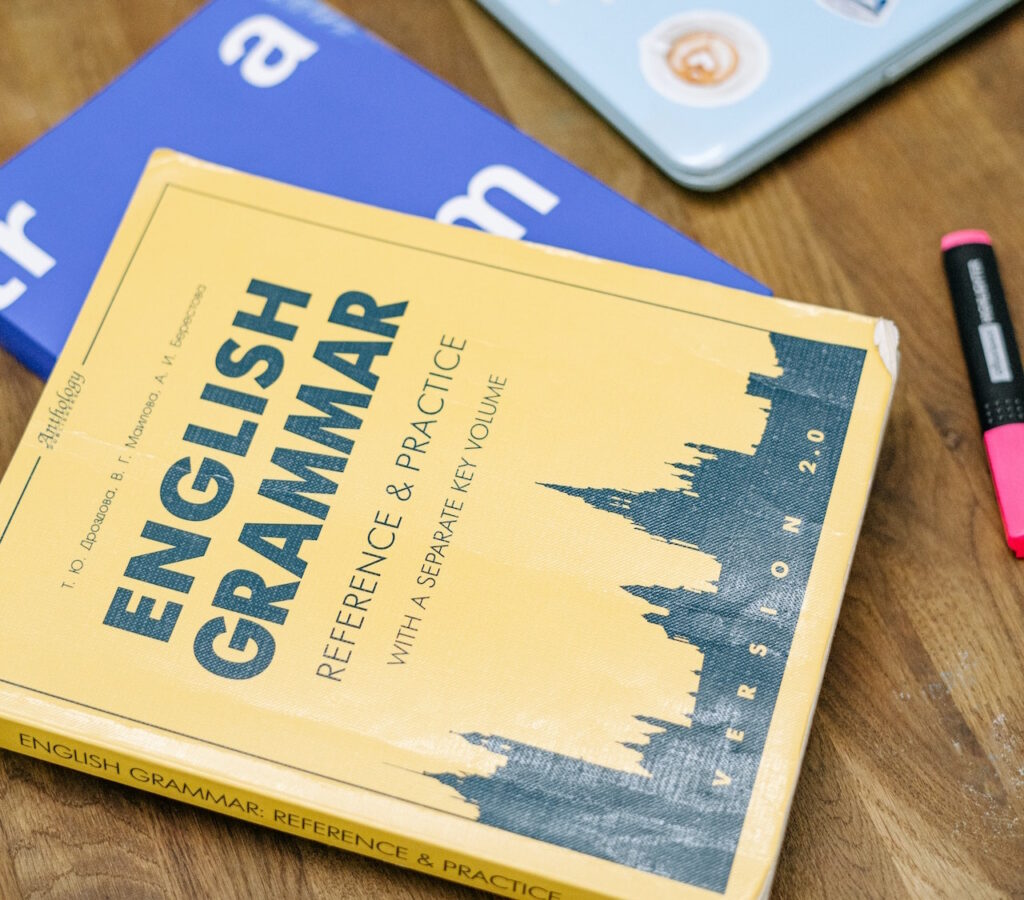People who know how to write better — how to communicate better — can position their businesses to have greater success. This is because they have the potential to get their messages across to their stakeholders more effectively and efficiently.
One easy and fast way to improve your writing (and progress toward all that downstream goodness) is to quit making common, avoidable grammar mistakes. Chop off that low-hanging fruit like a bad@ss ninja!
Doing this doesn’t have to be torturous or too difficult. And making improvements over time as you learn and develop your skills is totally legit!
This blog post will help you get started. We’ll touch on:
- Why you should care about grammar (and other) writing errors
- Common writing mistakes and how to fix them
- Where to look for more info

OK, , I’m gonna give it to you straight.
I’m a super nitpicky perfectionist who grew up with an English teach parent. Let’s just say that it shaped me and my sometimes-pedantic worldview. 🤣
BUT, what I’m telling you here today comes from a place of love. Not judgement.
I want you to be the abso best you can be.
So, I’m sharing the writing mistakes I see ALL. THE.TIME. that totally drive me bonkers(er).
If you commit these blunders, I encourage you to take the time and effort to learn to stop making them.

Why Grammar (& Other) Writing Mistakes Matter
Content riddled with mistakes can be problematic for many reasons. Like:
- It can create confusion or disseminate inaccurate information.
- It can be distracting, pulling readers/consumers away from the points you want to make.
- It can create harm. (Trust me, “Let’s eat grandma.” is very different than “Let’s eat, Grandma.”!)
- It could make you look unprofessional, unsophisticated, uneducated, unintelligent, incapable, or laaaazzyyyy AF, which can reflect on how others perceive your abilities elsewhere in your biz.
- It can make you look like you don’t really give a rat’s @ss about your work or your audience.
- It can put a dent in your ROI.
Uh, none of these are good for you or your business.
Error-free content is easier and quicker to consume and understand. This means that you’ll be able to connect with the people you want to reach even better than before! And this could translate into better conversations, conversions, and more.
Pretty much what its name implies it is. Activity blocking is the practice of chunking up similar kinds of work to be done during a dedicated period of time. Sometimes it’s referred to as Task Blocking — same thing.
You Don’t Need to Go Overboard with This, But…
If you’re a serious business person, you should act like it. Treat your communications with the same level of interest and diligence that you give other aspects of your biz.
All I’m suggesting is that you try. A little effort and caring goes a long freakin’ way.
And definitely give yourself props for improvements you make. They represent growing awareness, knowledge, and skills! That’s amazing!
The Caveat…
That said, remember that language is a living, malleable thing. And you are free to develop your own unique style.
So, if you want to do something that’s not technically correct — go for it. Just try to be informed and intentional about it. That way you can be consistent and come off looking authentic, polished, and like you have your sh*t together.

Tips for Preventing Writing Errors
It’s not always all about getting back on the straight and narrow after things have gone sideways.
The Best Offense Is a Good Defense
Hey, if that notion worked for George Washington, it works for me, too. Granted, we’re talking about grammar and writing, not warfare and country-building….
So, I’ll keep saying it: The best way to fix mistakes is not to make them in the first place.
Being proactive will save you time, money, effort, etc. over time. Those are precious resources you could dedicate to something else that builds your business or adds value in a meaningful way.
Why Do We Even F Up in the First Place?
Anyhoo, sometimes we make mistakes because of an awareness or knowledge gap — we don’t have the ability to realize we’re forking things up or to do things the right way (i.e., unknown unknowns and known unknowns).
Other times, it’s because our brains are elsewhere (or that damn autocorrect sabotaged our work!). We’re tired/rushing/multitasking/whatever — we didn’t recognize in the moment that our writing went a bit sideways.
I’m going to assume we aren’t committing errors because we just don’t care. After all, it’s our businesses, our thoughts and ideas, our livelihoods we’re talking about here. And, not only are people generally driven by personal self-interest, but they’re also often motivated by their self-interest in the people and things in their lives that they care about.
9 Tips for Preventing Grammar Mistakes
At any rate, here are some ways to correct/prevent grammar and other writing issues.
- Learn basic grammar. You can’t get around this. Get a grasp on the most used fundamentals — like subject-verb agreement, verb conjugations (past, present, and future tenses), plurals vs possessives, contractions, and pronoun usage. These will take you far!
. - Use readily available writing resources. Most content creation programs and apps have built-in grammar and spell-check features. Augment that with tools and resources like Grammarly and Hemmingway Editor.
. - Proofread, proofread, proofread. Did I mention proofread? Pretend like you’ve never seen the piece of writing before and don’t really know what’s in it. Then read the content line by line like you’re just learning to read — slowly, methodically, meticulously. This way you don’t skim over anything and overlook things like extra or omitted words, homophones, etc.
. - Do peer review. Even better, the buddy system. (Remember that?) Get someone with fresh eyes to review what you’ve written. Because they’re unfamiliar with the content, they may be less likely to overlook mistakes.
. - Practice! It’s true. The more you do something, the better you’ll get at it.
. - Read more. People who consume more written content tend to be better, more conscientious writers. Exposure to a variety of styles and genres — especially in materials that have been professionally written and/or edited — can help you develop a sense of what’s correct, contextually appropriate, and appealing and infuse your own writing with those elements.
. - Get a mentor. Nowhere does it say you have to do this on your own. Guidance and input can make a world of difference. And, you might see progress in your skills/content faster and with less difficulty. There are plenty of teachers, tutors, and coaches out there who are ready and eager to help you.
. - Hire a professional. Again, it ain’t written anywhere that you need to do everything yourself. Let a freelancer or consultant take on some of the bigger or harder writing tasks. While you can still learn from what they’ve crafted, you’re freed up to do other things that add value to your business.

Top 10 Grammar Gremlins & What to Do About Them
Yup, I constantly see these in emails, on webpages, on packaging and labels, etc. They make me go nuts.
Maybe it’s because I’ve got a more trained and seasoned eye. Maybe it’s because I’m steeped in writing and business communications all day every day…. Whatever the reason, these errors always jump out at me.
To be fair, English is one tricky language. I swear there are as many exceptions as there are rules! So, take comfort in knowing that both native speakers and language learners alike struggle with these.
But — regardless of your language proficiency — these faux pas are avoidable and fixable. You just have to want to communicate better and then align your actions with that desire. (I know, I know: Easier said than done!)
#1 Misues of Possessives & Plurals
Possessives show ownership. Nouns (people, places, or things) require an “’s” (apostrophe s — for singular nouns) or “s’” (s apostrophe — for plural nouns) to be made a possessive.
Plurals indicate a quantity of more than one. Generally speaking, plural nouns that aren’t possessive should not have an apostrophe! (OK, there are a few outliers and sometimes it depends on the style guide you’re following.)
Example 1:
- Singluar: No one’s submitted an FAQ yet.
- Plural: See our FAQs (or FAQ) page.
- Singular Possessive: This FAQ’s answer is outdated.
- Plural Possessive: These FAQs’ answers have been updated.
Example 2:
- Singluar: This email rocks.
- Plural: SBSF sends the most insightful emails ever.
- Singular Possessive: My email’s layout helps make it easier to read.
- Plural Possessive: His emails’ click-through rate averages in the double digits!
Notable (possible exceptions): Pluralizing (some) letters and (some) contractions may use an apostrophe s. (e.g., A’s, Do’s or Dos, Don’ts) Check your style guide to figure out how you should do it for your content.
#2 Homophone Mix-Ups
Homophones are words that sound the same(ish) but are spelled differently and have different meanings. A lot of the ones I see misused are mix-ups between possessive pronouns and contractions involving pronouns.
There are tons of homophones in English…and I can think of a few off the top of my head in French, too. So they must exist in every language?
Example 1: It’s vs Its (It’s an honor to be in its presence.)
- Its = Possessive pronoun, indicates something owns or possesses something else (e.g., Its hair is red.”
- It’s = Contraction for “It is”
Example 2: Your vs You’re (You’re in your happy place.)
- Your = Possessive pronoun, indicates you own or possess something else (e.g., Your name is melodic.”
- You’re = Contraction for “You are”
Example 3: Their vs They’re vs There (They’re pleased to be there with their family.)
- Their = Possessive pronoun, indicates a group owns or possesses something else (e.g., Their clothes are fancy.”
- They’re = Contraction for “They are”
- There = Adverb, indicates placement, position, or location (e.g., The books are over there.)
Example 4: To vs Too (Too many raccoons began to converge on the feeder.)
- To = A preposition indicating directional movement (e.g., ride to the store) or part of an infinitive verb (e.g., to wallow)
- Too = An adverb meaning “also” or “excessively” (Though he had too little time, he went, too.)
#3 Me vs I Incorrectly Implemented
This is a twofer: pronoun choice and placement. When talking about yourself and someone else, you should refer to yourself with the proper pronoun and put that pronoun after the other person/people. Putting the reference to yourself after the other person is considered more polite and correct.
Example 1:
- Wrong Pronoun, Wrong Order: Me and Kelly are going dancing.
- Wrong Pronoun, Correct Order: Kelly and me are going dancing.
- Wrong Order, Correct Pronoun: I and Kelly are going dancing.
- Correct Order, Correct Pronoun: Kelly and I are going dancing
Example 2:
- Wrong Pronoun, Wrong Order: It’s for I and Lance to decide.
- Wrong Pronoun, Correct Order: It’s for Lance and I to decide.
- Wrong Order, Correct Pronoun: It’s for me and Lance to decide.
- Correct Order, Correct Pronoun: It’s for Lance and me to decide.
Example 3:
- Wrong Pronoun, Wrong Order: They gave it to I and Zain.
- Wrong Pronoun, Correct Order: They gave it to Zain and I.
- Wrong Order, Correct Pronoun: They gave it to me and Zain.
- Correct Order, Correct Pronoun: They gave it to Zain and me.
I think the easiest way to remember which pronoun to use and when is to restate the sentence without including the other person/people. For instance:
| You Wouldn’t Say This | You Would Say This |
|---|---|
| Me am going dancing. | I am going dancing. |
| It’s for I to decide. | It’s for me to decide. |
| They gave it to I. | They gave it to me. |
#4 Subject/Verb Discord
Basically, the person or object in your sentences needs to match the action it’s paired with. We are talking conjugation. We are talking number agreement. To a lesser degree, you can throw using the proper tense in here, too.
Mostly, what I see is the verb not using the right form for the given subject. More often than not, this seems to happen with more complex sentences — like compound sentences with multiple clauses.
Example: Multiple or plural subjects with a verb conjugated for a single subject
- Wrong: Duke and Tila has a checkers set at their home.
- Correct: Duke and Tila have a checkers set at their home.
#5 Modifier Mayhem
A modifier is a word or phrase that describes or qualifies something else. Adjectives and adverbs are modifiers.
The biggest sin here is poor placement of modifiers in sentences such that they create confusion. Where the modifiers are placed, or the entire sentence structure, lacks clarity — the read can’t definitively tell what the modifier is linked to.
Example 1:
- Wrong: My dog befriended another neighborhood kid named Dahlia.
- Correct: My dog befriended another neighborhood kid and her name’s Dahlia.
With the first sentence, it’s hard to tell if the dog has befriended more than one neighborhood child name Dahlia. The second sentence better articulates the intended sentiment.
Example 2:
- Wrong: Despite stagnating for years, Sondra tries fresh approaches to boost sales.
- Correct: Sondra tries fresh approaches to boost sales despite them stagnating for years.
In the first sentence, you can’t quite tell if it’s Sondra or the sales that are stagnating. In the second sentence, the modifier is closer to the thing it relates to, which helps the reader know what’s meant.
#6 They vs It Misfit
A business (or brand or other inanimate entity) is both singular and not a human. Therefore, you shouldn’t use the pronouns “they/them/their” The correct pronoun is “it/its.”
Obviously, if you’re referring to more than one business, you’d use “they.” But just because this is how pluralization of “it” works!
And, of course, you have to make sure the pronoun and its verb agree….
Example 1: I went to the store but the store is out of milk. (Single business)
- Wrong: I went to the store but they’re out of milk.
- Correct: I went to the store but it’s out of milk.
Example 2: Zips clothing is overpriced. (Single business)
- Wrong: Their clothing is overpriced.
- Correct: Its clothing is overpriced.
Example 3: Pandora’s Pizzas in the downtown area are open late. (Multiple businesses)
- Wrong: It’s open late.
- Correct: They’re are open late.
#7 Adjective vs Adverb Fails
Adjectives are used to modify nouns, pronouns, or sense verbs (e.g., feel, seem, look, appear, smell, taste, sound). Adverbs are used to describe verbs adjectives or other adverbs. They’re not the same and they’re not interchangeable.
Pro Tip: Most adverbs end in -ly.
Example 1: Dark vs Darkly
- Wrong: The room is darkly.
- Correct: The room is dark.
- Wrong: The room is dark lit.
- Correct: The room is darkly lit.
Example 2: Real vs Really
- Wrong: The gift is real nice.
- Correct: The gift is really nice.
- Wrong: That’s a really gemstone.
- Correct: That’s a real gemstone.
Example 3: Good (Adjective) vs Well (Adverb)
- Wrong: I did good on my exam.
- Correct: I did well on my exam.
- Wrong: She makes well cookies.
- Correct: She makes good cookies.
- Wrong: That outfit looks well on you.
- Correct: That outfit looks good on you.
#8 Who vs That Confusion
Use “who” with a person/people and “that” other stuff. You can also use “that” when referring to a bunch of people when you’re emphasizing the group, rather than its individual members.
Example 1: Who
- Wrong: This is the belt who I wore.
- Correct: This is the dentist who helped me.
- Correct: Yann is who I trust.
- Correct: She knows Jack, who’s on his way up now.
Example 2: That
- Wrong: Val is the one that sews toys for pets.
- Wrong: The boat who Jim got is motorized.
- Correct: The boat that Jim got is motorized.
- Correct: The youth group that I belonged to met at the rec center.
#9 Then vs Than Switching
Then is a marker of time sequence — after X comes Y. Than is a conjunction or preposition used to relate something to another thing in comparisons.
Example 1: Then
- Wrong: We’ll have brunch than go for a walk.
- Correct: We’ll have brunch then go for a walk.
- Wrong: I was younger than.
- Correct: I was younger then.
Example 2: Than
- Wrong: Dorie is taller then me.
- Correct: Dorie is taller than me.
- Wrong: Lazybones — you always sit rather then do!
- Correct: Lazybones — you always sit rather than do!
#10 Crimes Against Proper Punctuation
This is a big, encompassing buck of miscellany. Suffice it to say, everything from periods and commas to quotation marks and semicolons to em dashes and apostrophes to exclamation point and ellipses are misused.
A lot. In so many ways I couldn’t even begin to catalog them. And often more than one crime is committed at a time — yikes!
I think the main categories of punctuation pitfalls are:
- Incorrect usage — There’s punctuation; it’s just wrong. Like putting a period where there should be a question mark.
- Omissions — Text that should have punctuation doesn’t. This could be anything from abbreviations without periods (e.g., Mr Knoff instead of Mr. Knoff) to sentences lacking anything at their end (e.g., an exclamation point).
- Extras — This would be when additional (and totally superfluous) punctuation is slipped in. I’m thinking about random commas sprinkled about in sentences or double periods because no one proofread.
- Inconsistency — Punctuating one way here and another way there. Punctuation is all over the map, not necessarily applied incorrectly but definitely creating style havoc and perhaps an uneven reader experience.
- Overload — Sometimes you lay your eyes on writing that’s got punctuation everywhere! It looks weird and can be distracting (even when it isn’t technically wrong).

Dive Deeper, Learn More, Do Better
Let’s pretend that you’re somewhere on the spectrum of mildly curious to ready to completely nerd out on grammar minutiae. These resources will get you going.
- 30 of the Most Common Grammatical Errors We All Need to Stop Making (HubSpot)
- 30 Common Grammar Mistakes to Avoid (Grammarly)
- 18 Most Common Grammar Mistakes (Yourdictionary.com)
- Common English Grammar Mistakes and How to Fix Them (Oxford International English Schools)
- Top 20 Errors in Undergraduate Writing (Stanford University Hume Center for Writing and Speaking)
- Common Grammar Errors (TAMU University Writing Center)
- 11 Common Grammar Mistakes that Make People Cringe—and Make You Look Less Smart (CNBC.com)
- 37 Common Grammar Rules Everyone Breaks (Good Housekeeping)
- 99 Most Common Grammar Mistakes (Writer’s Room)
- The 10 Most Common Grammar Mistakes (Proofed)
- 20 Most Common Grammar Mistakes (and How to Fix Them) (ProWritingAid)
- 15 Common Grammar Mistakes That Kill Your Writing Credibility (Authority Pub)
Need Professional [Writing] Help?
Me me me! I can help you! Let’s chat about your copywriting or content creation needs, copy coaching and review, or tools and resources I can offer you. You don’t have to do this alone! (Thank gourd.)

Drive Your Biz Success through Better Writing
Knowing how to write better can be a key to helping your business thrive. And, learning the skills to communicate better via written content doesn’t have to be overwhelming, hard, complex, time-consuming, [fill in the blank here with your ready excuse!].
All it takes is acquiring:
- A basic understanding of some language rules and writing fundamentals
- An awareness of some of the most common grammar mistakes
- A mindest and process that prioritize preventing (and correction) errors in an to communicate better for greater biz success down the line.
From the Writers’ Room
Tell me…
Which writing errors do you find yourself making most? Have you got a plan in place to grow your skills? How do you think your current/future (after skill building) communication capabilities impact your business?
What mistakes do you see a lot of that drive you bonkers? Do you have any favorite tips or resources for better writing that you’d like to share?
Feel free to send your responses my way and I’ll share the cream of the crop. Thanks!





